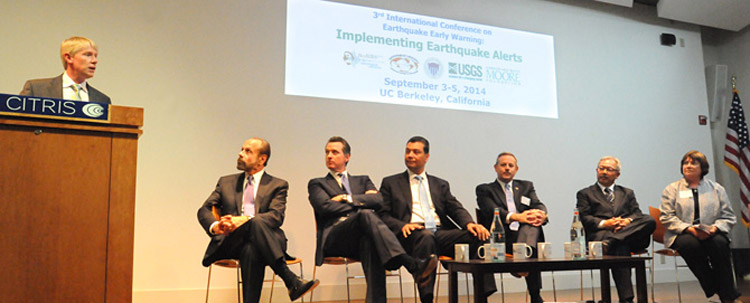Political leaders agree: The time for a statewide earthquake early warning system is now.
In the wake of the recent 6.0 magnitude Napa earthquake, California legislators joined scientists and emergency-response experts to kick off a three-day international conference at UC Berkeley on earthquake early warning.

September 4, 2014

Berkeley Seismological Laboratory director Richard Allen introduces (from left) state Sen. Jerry Hill, Lt. Gov. Gavin Newsom, state Sen. Alex Padilla, Office of Emergency Services director Mark Ghilarducci, San Francisco Mayor Ed Lee and USGS acting director Suzette Kimball. Peg Skorpinski photo.
Last week’s 6.0 Napa earthquake was a wake-up call not only for the wine country. The shaking was also felt in Sacramento and San Francisco, galvanizing a host of politicians to go on record urging immediate funding for a statewide earthquake early warning system.
Four of those figures – state Sens. Alex Padilla and Jerry Hill, Lt. Gov. Gavin Newsom and San Francisco Mayor Ed Lee – brought that message yesterday (Sept. 3) to the opening of a three-day international conference at UC Berkeley about early warning systems and how to implement them. The conference was organized by the Berkeley Seismological Laboratory and hosted by its director, Richard Allen.
“The Napa quake was the latest reminder – thankfully not too tragic – of the urgency with which we need to act to establish an earthquake early warning system to help protect California,” said Padilla, who represents the San Fernando Valley and last year introduced legislation, SB135, to create such a system.
Alerts are sent out based on data from the California Integrated Seismic Network, warning of impending ground shaking, the expected severity of shaking and how many seconds before it starts. Agencies have seconds to a minute to, for example, slow commuter trains, close valves, bring elevators to a stop at the nearest floor or stop amusement park rides.
“We need to turn over every rock necessary to find funding,” Padillasaid, noting that what California does would “become the backbone” of a western regional and national system.
State needs resilient system
The California legislature approved and Gov. Jerry Brown signed SB135, but the bill provided no funding for the project. Sacramento left implementation details in the hands of the state Office of Emergency Services (OES), which is currently working on a statewide plan.
“We are in the last mile of getting it implemented. This is not, from a funding perspective, going to be that hard,” OES director Mark Ghilarducci assured the overflow audience and more than a dozen reporters in Sutardja Dai Hall’s Banatao Auditorium. Rather than relying on increasingly unreliable state funding, however, he expects to enlist businesses and communities in building a “resilient” system and educating the public on how to respond to a quake alert.
“If it’s not reliable and accurate, then we start to lose our credibility and businesses start to lose profits,” he said.

Richard Allen, professor of earth and planetary science and director of the Berkeley Seismological Laboratory. Peg Skorpinski photo.
Acting director Suzette Kimball of the U.S. Geological Survey (USGS), which would eventually operate a regional or national early warning network, praised California’s efforts to lead the way in earthquake early warning, which is one of USGS’s priorities, she said. The agency recently issued a report laying out plans to strengthen the current state California seismic network; rigorously test the ShakeAlert system build by UC Berkeley, Caltech and University of Washington seismologists; and manage an alerting system.
Yet the question lingered: Where will the money for the California system – estimated at $80 million to establish and $15 million annually to maintain – come from? Like the state’s tsunami warning system, it would send an alert seconds to a minute in advance of shaking from a distant earthquake. (ShakeAlert gave Bay Area agencies five to 10 seconds’ warning of shaking from the Napa temblor; it cannot, however, provide early warning for those at a quake’s epicenter, such as the residents of Napa on Aug. 24.)
“We have been demonstrating earthquake early warning for more than two years with ShakeAlert,” Allen said. “But what we were lacking was something to focus the public on the need to fund the system to do this right.” In the wake of the Napa quake, “the spotlight is … on this topic, so we are really hoping to make progress. Early warning can lessen the impact of future quakes in terms of dollars lost and lives saved.”
‘No reason for California to wait’
Speakers suggested funding options, such as taking money from a water bond on the November ballot or from money set aside for a state high-speed rail system. In an op-ed in yesterday’s San Jose Mercury News, Padilla suggested that the state legislature pass an emergency appropriation.

State Sen. Alex Padilla, who has led legislative efforts to create a California earthquake early warning system. Peg Skorpinski photo.
“There is no reason for California to wait,” he wrote. “We appropriate money for a variety of state projects. This one will actually save lives and address one of the most serious threats facing our state.”
While Padilla is now termed out of the legislature, state Sen. Jerry Hill, a UC Berkeley alum who represents much of Silicon Valley, is pushing for state funding. The public “expects us to find solutions,” he noted.
“It’s now a question of political will,” said Newsom.
The Third International Conference on Earthquake Early Warning continues today and Friday, focusing on the science of detection and warning, how countries such and Japan and Mexico have created nation-wide earthquake alerting systems, and effective strategies for building such systems in California, the U.S. West Coast, Canada and countries across the globe.
On Friday, representatives of organizations ranging from NASA and Chevron to PG&E and the Bay Area Rapid Transit (BART) system will discuss how they plan to use the alerting information. Some of these agencies are already testing ShakeAlert, which is funded in part by the Gordon and Betty Moore Foundation and the USGS.
RELATED INFORMATION